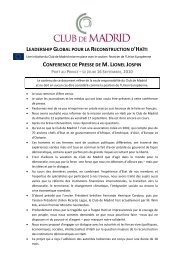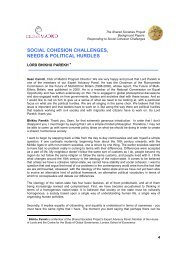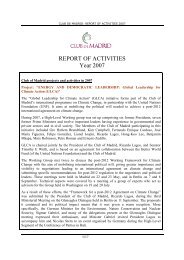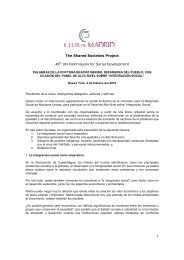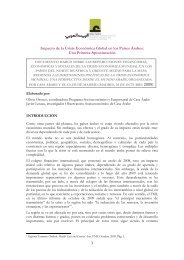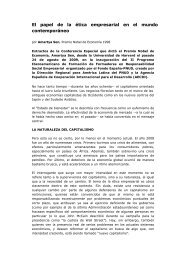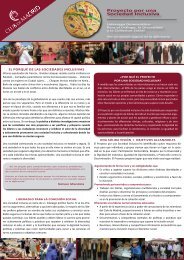Does Diversity Pay? - American Sociological Association
Does Diversity Pay? - American Sociological Association
Does Diversity Pay? - American Sociological Association
You also want an ePaper? Increase the reach of your titles
YUMPU automatically turns print PDFs into web optimized ePapers that Google loves.
214—–AMERICAN SOCIOLOGICAL REVIEW<br />
to which each individual belongs is considered<br />
to be one racial group, and n 1 .|.|. n i is the number<br />
of individuals in the various groups (so that<br />
3n i = N for a population with three racial<br />
groups). If all the individuals in a racial group<br />
are concentrated in one category, the measure<br />
would be .0. To constrain the RID between .0<br />
and 1.0, I calculate the actual level of diversity<br />
as a proportion of the maximum level possible<br />
with the specified number of races, that is, 1 –<br />
(1/i). In a population with an even racial distribution,<br />
the RID would equal 1.00.<br />
One limitation of the RID (as with most<br />
indexes of dissimilarity) is that it treats overrepresentation<br />
and underrepresentation of subgroups<br />
as mathematically equivalent for<br />
computational purposes. Arguably, an organization<br />
with a 20 percent underrepresentation of<br />
minorities (relative to the population) would be<br />
very different from an organization with a 20<br />
percent overrepresentation of minorities (relative<br />
to the population).<br />
To correct for this limitation, I modify the<br />
RID to incorporate the idea that power relations<br />
between superordinate and subordinate<br />
groups are asymmetrical. The key idea is that<br />
of parity. The Asymmetrical Index of <strong>Diversity</strong><br />
(AID) is<br />
AID = (1 – S) if S > P<br />
AID = (1 – P) if P ≥ S<br />
where S is the proportion of the organization<br />
composed of the superordinate group, and P is<br />
the proportion of the population composed of<br />
the superordinate group.<br />
Scores can range from 0 (completely homogeneous<br />
organization composed of the superordinate<br />
group) to “parity” (i.e., 1 – P) (where<br />
the superordinate and subordinate groups have<br />
reached proportional representation in the<br />
organization). For example, if the superordinate<br />
group constitutes 75 percent of the population,<br />
AID scores can range from 0 to .25 (or<br />
25 when multiplied by 100). If the superordinate<br />
group constitutes 50 percent of the population,<br />
AID scores can range from 0 to .50 (or 50 when<br />
multiplied by 100).<br />
The racial diversity index and the gender<br />
diversity index are both operationalized using<br />
two alternative premises: (1) without the underlying<br />
notion of parity (i.e., RID) and (2) with an<br />
underlying notion of parity mattering (i.e., AID-<br />
R and AID-G). Both models work well, but the<br />
AID-R and AID-G models with the parity<br />
assumption give a better fit. Moreover, they<br />
provide a theoretical rationale for why diversity<br />
is related to business outcomes. Given these<br />
results, I use both the AID-R and AID-G (parity)<br />
operationalizations (for both race and gender).<br />
In this study, the superordinate racial group,<br />
whites, make up 75 percent of the population in<br />
the 1996 to 1997 NOS. Scores on the asymmetrical<br />
index of diversity for race thus range<br />
from a low of 0 (homogenous white) to a high<br />
of 25 (racial parity). Males, the superordinate<br />
gender, make up 54 percent of the population<br />
in the 1996 to 1997 NOS. Scores on the asymmetrical<br />
index of diversity for gender thus range<br />
from a low of 0 (homogenous male) to a high<br />
of 46 (gender parity).<br />
BUSINESS PERFORMANCE<br />
To measure average annual sales revenue,<br />
respondents were asked, “What was your organization’s<br />
average annual sales revenue for the past<br />
two years?” Responses range from 0 to 60 billion<br />
dollars. For multivariate analysis, I add a<br />
small number (.01) to each observation before<br />
dividing it by 1 million and taking the log of<br />
these values.<br />
To measure the number of customers, respondents<br />
were asked, “About how many customers<br />
purchased the organization’s products or services<br />
over the past two years?” Responses range<br />
from 0 to 25 million customers.<br />
To measure perceived market share, respondents<br />
were asked, “Compared to other organizations<br />
that do the same kind of work, how<br />
would you compare your organization’s performance<br />
over the past two years in terms of<br />
market share? .|.|. Would you say that it was (1)<br />
much worse, (2) somewhat worse, (3) about the<br />
same, (4) somewhat better, or (5) much better?”<br />
To measure relative profitability, respondents<br />
were asked, “Compared to other organizations<br />
that do the same kind of work, how would you<br />
compare your organization’s performance over<br />
the past two years in terms of profitability? .|.|.<br />
Would you say that it was (1) much worse, (2)<br />
somewhat worse, (3) about the same, (4) somewhat<br />
better, or (5) much better?”



